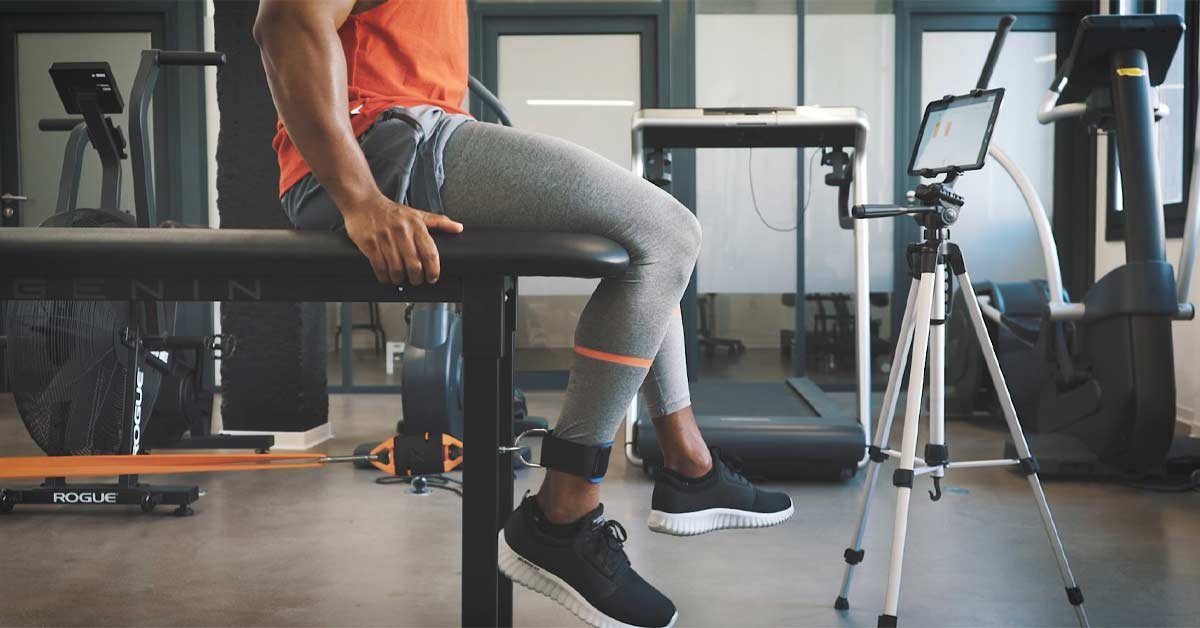Multiple times a week, I get asked, “Which handheld dynamometer (HHD) do you like?” If you’re looking for a simple guide to compare all the different devices on the market, you can view one here. However, my answer is always: “It depends on your setup.”
Most handheld dynamometers are nearly the same in regard to specifications, so it really depends on which tests you want to do and what fixation sites you have at your disposal, says @MuyVienDPT. Share on XMost devices are nearly the same in regard to specifications, so it really depends on which tests you want to do and what fixation sites you have at your disposal. This article will give you confidence in your final device of choice because you have made all the considerations to use an HHD reliably for good data.
What Is a Handheld Dynamometer and Why Is the Market Expanding?
Dynamometers are force gauges that measure the amount of force pushed into or pulled against the device (figure 1). The device then shows the amount of force produced on its screen, or via an app if it is a Bluetooth-based device. HHDs specifically fit in your hands and are portable, hence the name. Compared to popular, research-grade isokinetic dynamometers found in labs, such as the HUMAC Norm and Biodex, they are cheaper and portable. However, they may not be as accurate or reliable and may have lower load capacities (table 1).1–5
Different types of muscle strength tests can be performed with an HHD. A “make” test means the dynamometer is held still by the test proctor or an external fixation (figure 2), and the tester pushes into the device as hard as possible. A “break” test is when the tester holds their limb as still as possible as the test proctor directs a force to overcome the tester’s resistance. This type of test often results in larger values since it biases a muscle group’s eccentric capability.
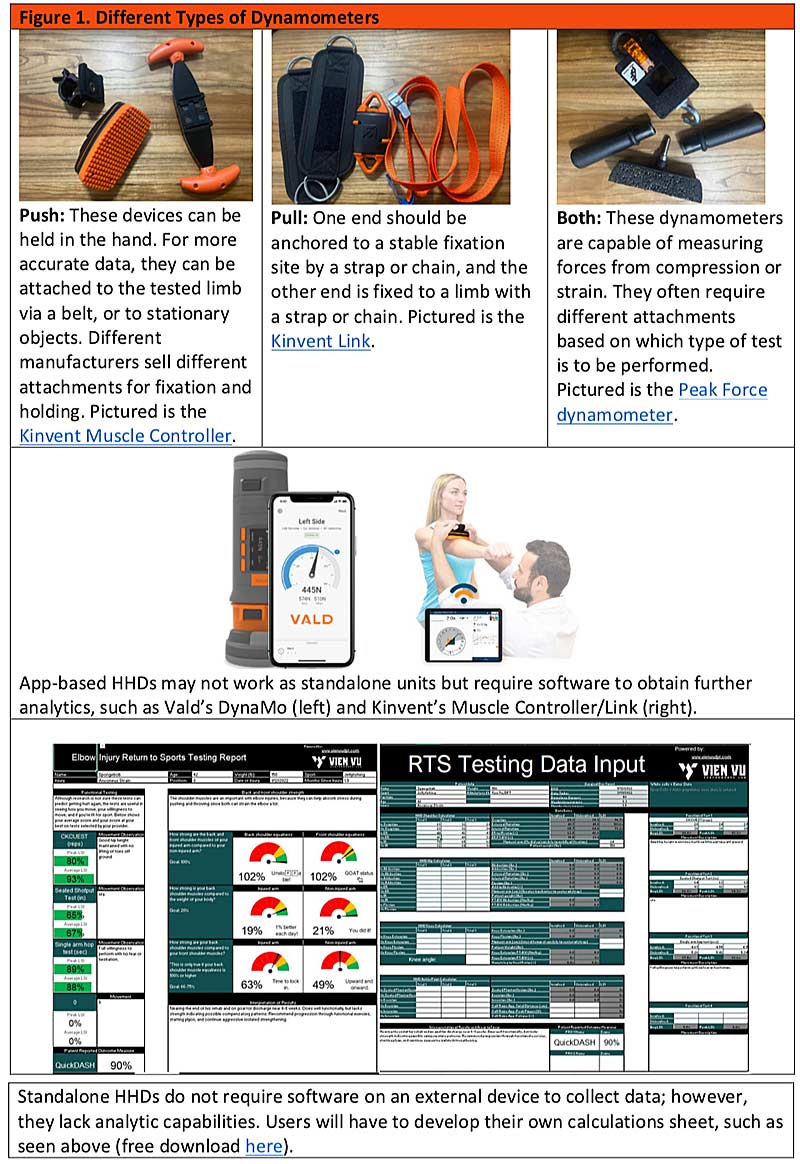

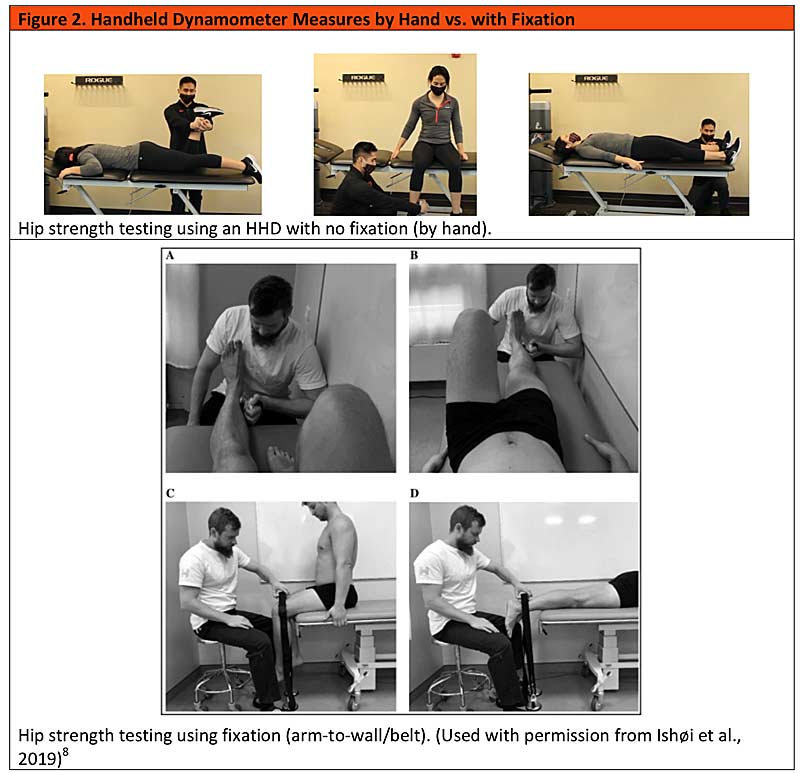
In the past, HHDs were only found in labs and clinical settings; however, their rapid growth into the performance world may be due to two main reasons.
- Over the past decade, you have likely attended some kind of educational session called “Bridging the Gap Between Rehab and Performance.” Such sessions have enhanced communications between rehab and performance departments. Performance coaches now understand what should be measured in the rehab space (table 2), and manufacturers are taking notice. For example, Vald Performance, a company well-known in the performance space for its force plates and hamstring measurement device, just recently released its version of a push-and-pull HHD.
- Another reason the market has been exploding is that, despite evidence supporting objective measures, rehab professionals have been shown not using objective methods to measure strength. For example, 56% of physical therapists use a subjective “feel” for quad strength measurement when they clear their athletes for return to sport.11 These daunting statistics have been popularized, and rehab professionals now see the need to purchase devices to ensure the safety of their athletes.
Both professions have found a need to measure isolated strength. Although specific decisions often lean on one discipline over another depending on an athlete’s recovery timeline (i.e., physicians giving final clearance for an athlete returning to sport), the act of data collection is not exclusive to any profession.
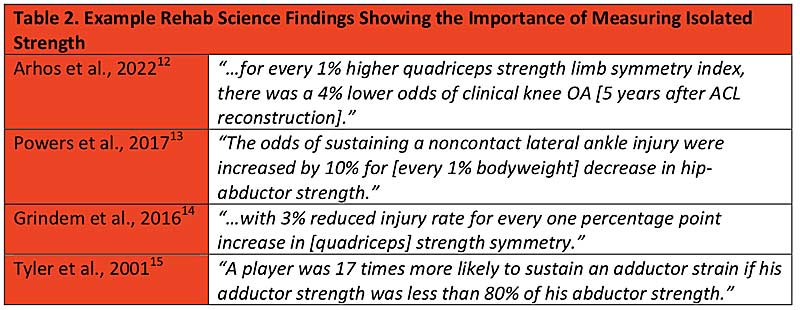
Hopefully, you see the exciting uses and opportunities for handheld dynamometers. Now we will focus on considerations for making a purchase.
Determine Your Process Before You Make Your Purchase
Data is only applicable to decision-making if it is valid and reliable. As previously shown in table 1, fixation greatly influences whether your HHD data is reliable and valid. For this reason, your purchasing decision should be largely about how you plan to fixate your device as you design quick and efficient methods to test your athletes. Often assumed to be easy, fixation is actually the largest problem users have (figure 3), as they end up purchasing devices before they fully account for what tests they want to perform and how they will perform them. They buy the devices and then realize their environment does not have proper objects to fixate to, nor do they have good attachments for their devices.
Your purchasing decision should be largely about how you plan to fixate your handheld dynamometer as you design quick and efficient methods to test your athletes, says @MuyVienDPT. Share on XCompanies such as Vald (Force Frame) and Kangatech (KT360) have developed dynamometers attached to frames, which can be excellent options as long as you understand they are not capable of “break” tests and are relatively bulky compared to their handheld counterparts. For one reason or another, many professionals prefer the portability of HHDs. Therefore table 3 has different fixation considerations you should have when purchasing an HHD, even including which tables are in your environment (figure 4).
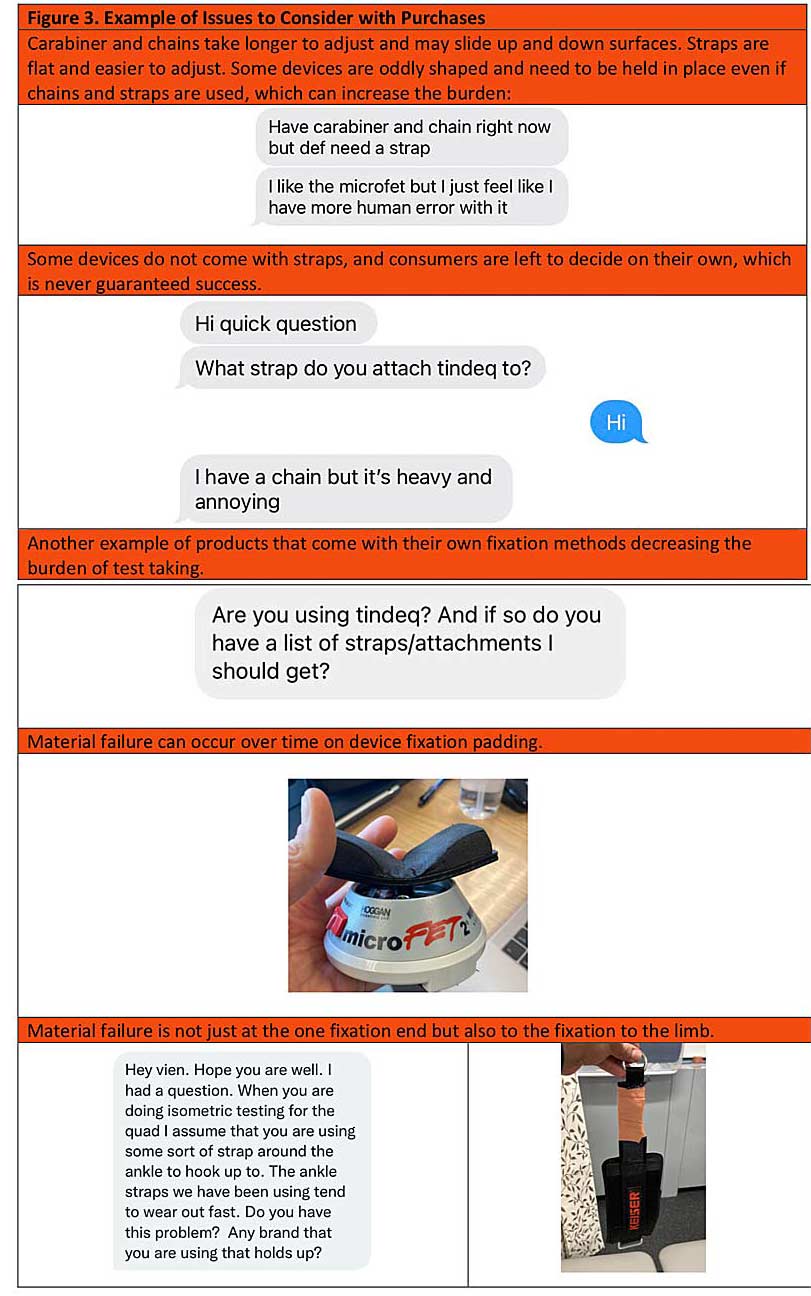

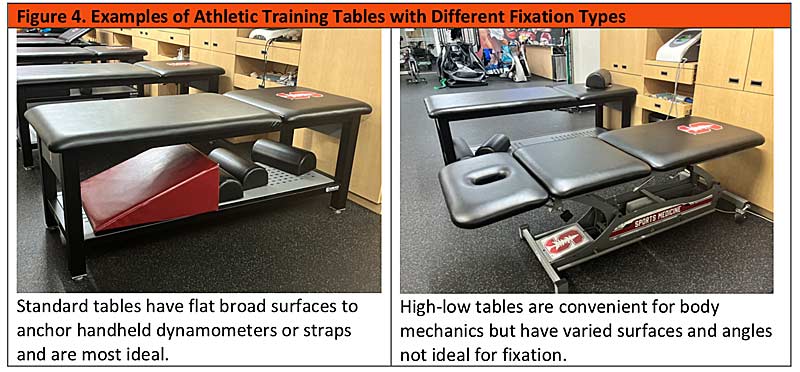
Excellent fixation is key during testing, but certain circumstances call for non-fixated methods. Say, for example, you have a team of 30 athletes that you would like to test for hip strength. That’s 30 athletes, two hips each, three trials each limb, and 3–5 seconds each trial… You get it; it’s a lot of time.
I would feel comfortable without belt or wall fixation because the evidence shows good intrarater reliability, and I would be the one administering these tests over time anyway. I would caution myself in comparing my peak force norms to those in the research or from colleagues since the evidence suggests strength and sex influence testing scores.16 The data I would then use is symmetry and muscle group ratios since all of my data has a steady degree of systematic error (constant and stable error). I can even still use the absolute values if I compare them within my own database over the years if I was still the one taking them each year.
This example is just one of many scenarios emphasizing the need to consider your testing process before purchasing a device. There are many other considerations you may have to make (table 4) to determine which HHD is right for you.
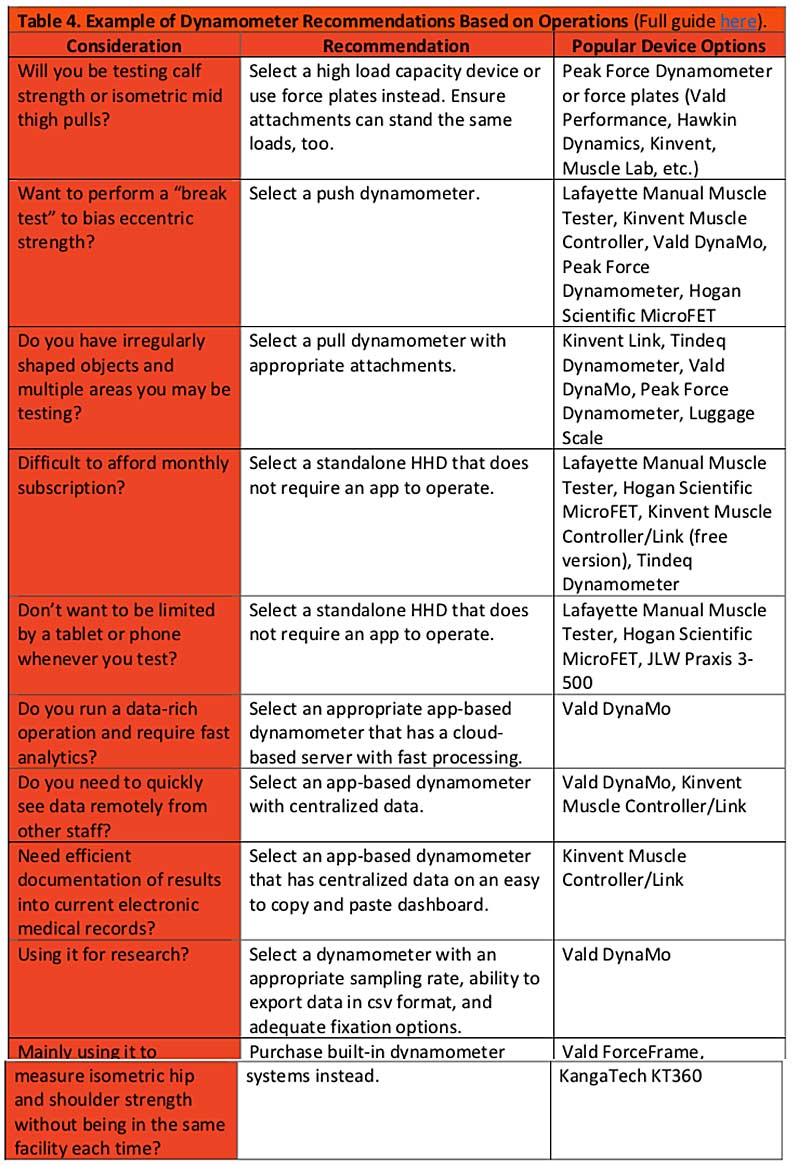
Finally! You planned out all the different ways you will test isolated muscle strength and decided on your purchase. Now comes a whole different process consideration: what is the quickest way to test muscle regions that requires the least amount of position changing between you and the athlete?
Performance coaches now understand what should be measured in the rehab space, and manufacturers are taking notice, says @MuyVienDPT. Share on XI will largely save this for another article—in the meantime, see figure 5, which will help accelerate your testing methods with your new dynamometer. Learning curves are expected with any new technology, and you will surely refine the process as you use your HHD more. Just be glad you approached technology correctly by determining your needs and process before the purchase.

Since you’re here…
…we have a small favor to ask. More people are reading SimpliFaster than ever, and each week we bring you compelling content from coaches, sport scientists, and physiotherapists who are devoted to building better athletes. Please take a moment to share the articles on social media, engage the authors with questions and comments below, and link to articles when appropriate if you have a blog or participate on forums of related topics. — SF
References
1. Sinacore JA, Evans AM, Lynch BN, Joreitz RE, Irrgang JJ, and Lynch AD. “Diagnostic Accuracy of Handheld Dynamometry and 1-Repetition-Maximum Tests for Identifying Meaningful Quadriceps Strength Asymmetries.” Journal of Orthopaedic & Sports Physical Therapy. 2017;47(2):97–107. doi:10.2519/jospt.2017.6651
2. Lesnak J, Anderson D, Farmer B, Katsavelis D, and Grindstaff TL. “Validity of Hand-Held Dynamometry in Measuring Quadriceps Strength and Rate of Torque Development.” International Journal of Sports Physical Therapy. 2019;14(2):180–187.
3. Mentiplay BF, Perraton LG, Bower KJ, et al. “Assessment of Lower Limb Muscle Strength and Power Using Hand-Held and Fixed Dynamometry: A Reliability and Validity Study.” PloS One. 2015;10(1):e0140822. doi:10.1371/journal.pone.0140822
4. Martins J, da Silva JR, da Silva MRB, and Bevilaqua-Grossi D. “Reliability and Validity of the Belt-Stabilized Handheld Dynamometer in Hip- and Knee-Strength Tests. Journal of Athletic Training. 2017;52(9):809–819. doi:10.4085/1062-6050-52.6.04
5. Johansson FR, Skillgate E, Lapauw ML, et al. “Measuring Eccentric Strength of the Shoulder External Rotators Using a Handheld Dynamometer: Reliability and Validity. Journal of Athletic Training. 2015;50(7):719–725. doi:10.4085/1062-6050-49.3.72
6. Kolber MJ, Beekhuizen K, Cheng MSS, and Fiebert IM. “The reliability of hand-held dynamometry in measuring isometric strength of the shoulder internal and external rotator musculature using a stabilization device.” Physiotherapy: Theory and Practice. 2007;23(2):119–124. doi:10.1080/0959398071213032
7. Cools AMJ, Vanderstukken F, Vereecken F, et al. “Eccentric and isometric shoulder rotator cuff strength using a hand-held dynamometer: reference values for overhead athletes.” Knee Surgery, Sports Traumatology, Arthroscopy. 2016;24(12):3838–3847. doi:10.1007/s00167-015-3755-9
8. Ishø L, Hölmich P, and Thorborg K. “Measures of Hip Muscle Strength and Rate of Force Development Using a Fixated Handheld Dynamometer: Intra-Tester Intra-Day Reliability of a Clinical Set-up.” International Journal of Sports Physical Therapy. 2019;14(5):715–723.
9. Krause DA, Neuger MD, Lambert KA, Johnson AE, DeVinny HA, and Hollman JH. “Effects of examiner strength on reliability of hip-strength testing using a handheld dynamometer.” Journal of Sports Rehabilitation. 2014;23(1):56–64. doi:10.1123/jsr.2012-0070
10. Thorborg K, Petersen J, Magnusson SP, and Hölmich P. “Clinical assessment of hip strength using a hand-held dynamometer is reliable.” Scandinavian Journal of Medicine & Science in Sports. 2010;20(3):493–501. doi:10.1111/j.1600-0838.2009.00958.x
11. Greenberg EM, Greenberg ET, Albaugh J, Storey E, and Ganley TJ. “Rehabilitation Practice Patterns Following Anterior Cruciate Ligament Reconstruction: A Survey of Physical Therapists.” Journal of Orthopaedic & Sports Physical Therapy. 2018;48(10:801–811. doi:10.2519/jospt.2018.8264
12. Arhos EK, Thoma LM, Grindem H, Logerstedt D, Risberg MA, and Snyder-Mackler L. “Association of Quadriceps Strength Symmetry and Surgical Status With Clinical Osteoarthritis Five Years After Anterior Cruciate Ligament Rupture.” Arthritis Care Research. 2022;74(3):386–391. doi:10.1002/acr.24479
13. Powers CM, Ghoddosi N, Straub RK, and Khayambashi K. “Hip Strength as a Predictor of Ankle Sprains in Male Soccer Players: A Prospective Study.” Journal of Athletic Training. 2017;52(11):1048–1055. doi:10-4085/1062-6050-52.11.18
14. Grindem H, Snyder-Mackler L, Moksnes H, Engebretsen L, and Risberg MA. “Simple decision rules can reduce reinjury risk by 84% after ACL reconstruction: the Delaware-Oslo ACL cohort study.” British Journal of Sports Medicine. 2016;50(13):804–808. doi:10.1136/bjsports-2016-096031
15. Tyler TF, Nicholas SJ, Campbell RJ, and McHugh MP. “The association of hip strength and flexibility with the incidence of adductor muscle strains in professional ice hockey players.” American Journal of Sports Medicine. 2001;29(2):124–128. doi:10.1177/03635465010290020301
16. Thorborg K, Bandholm T, Schick M, Jensen J, and Hölmich P. “Hip strength assessment using handheld dynamometry is subject to intertester bias where testers are of different sex and strength.” Scandinavian Journal of Medicine & Science in Sports. 2013;23(4):487–493. doi:10.1111/j.1600-0838.2011.01405.x
17. Ness BM, Tao H, Javers D, et al. “Development of an Upper Extremity ‘Swing Count’ and Performance Measures in NCAA Division I Volleyball Players over a Competitive Season.” International Journal of Sports Physical Therapy. 2019;14(4):582–591.

